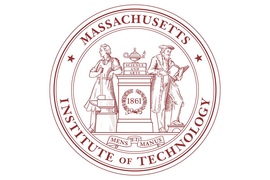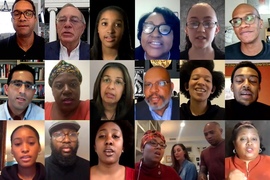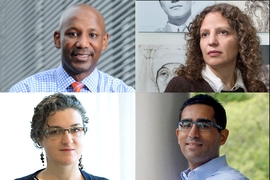Darnisa Amante-Jackson and her husband were excited to be on an eight-day drive from New Hampshire across the country to see the Grand Canyon two years ago. On the outskirts of a small prison town in Colorado, they pulled into a small gas station to fuel up their Jeep.
As Amante-Jackson recounted during her keynote address for MIT’s inaugural Day of Dialogue, there was a sign on the gas station door that day which read, “No cloaks, no hoods.” Then, the owner came out holding a shotgun and asked who they planned to visit at the prison.
“I told him we were on vacation,” said Amante-Jackson, who is an educational and racial equity strategist. “And then I said, ‘Excuse me, I’m curious. Can you help me understand the sign on the door? I said, ‘Is this an anti-wizard association? Is this the place for Muggles only?’”
The station owner laughed and said that cloaks and hoods referred to the Ku Klux Klan, or “the Brotherhood” as he tried to euphemize it. He didn’t allow members of the Klan — which he admitted belonging to as well — to wear cloaks and hoods in the store because many of them were drug addicts, and easily stole items from him under the cloaks’ covers.
In response, Amante-Jackson, a Black woman, did something unexpected. She told him she understood the pain and chaos of drug addiction.
“I said, ‘Wow. I grew up someplace where there’s a lot of drugs. I know what it’s like to have your friends and family not be the people you thought you once knew,’” she told the man. As the conversation proceeded, he put down his gun and told her no one had ever talked to him or empathized with his struggles that way. He ultimately wished the couple well and gave them directions for a safe way out of town.
Although Amante-Jackson, co-founder and president of Disruptive Equity Education Project, clearly disagreed with everything the man stood for, she told the MIT audience on Aug. 5 that it was important for her to let him know they had a “shared humanity.”
Empathy was one of six points Amante-Jackson emphasized during her keynote talk on the ethos of embracing anti-racism. “This [anti-racism] dialogue will never be easy, but there is such a greater good on the other side of it, and that is true anti-racist practice,” she said.
But this work is not going to be finished anytime soon, Amante-Jackson warned: “We only have one lifetime, and there’s only so much you can do in one lifetime towards the dismantling of oppression. … Your children’s children’s children’s children will still be having this dialogue, and it’s not because we weren’t urgent for change.”
Talk to inspire action
More than 1,000 people participated in MIT’s Day of Dialogue, a day meant to inspire conversation, reflection, and activism in spurring anti-racism.
Day of Dialogue committee co-chair La-Tarri Canty organized the day after many in the MIT community expressed a desire to learn about systemic racism following George Floyd’s killing in May. MIT President L. Rafael Reif spoke at the event and thanked both Canty and her co-chair Jason McKnight.
“I’m greatly inspired that this event has attracted so many people from across MIT … many more people are paying attention. That includes people who — before now — have not fully understood the extent of systemic racism,” Reif said.
This new energy around anti-racism could be felt in the various sessions throughout the day. Heather Hackman, who teaches about social justice issues, gave a lunchtime keynote talk on “Racial Equity and the Urgency of Now.” Author and educator Crystal Fleming led a workshop on “Understanding White Supremacy as a System of Power.” Day of Dialogue attendees could choose from more than 20 different virtual workshops on topics ranging from understanding challenges that Native Americans face, to supporting Black, Indigenous, and People of Color (BIPOC) and LGBTQ+ students.
Co-chairs Canty and McKnight were impressed that so many people signed up. “I knew there was a need in the community for this conversation, but you never know how many, and in what way people will show up,” Canty said. “The sheer number of registrants and the continued high number of attendees through the day show the strong desire of the community to engage.”
McKnight said initial feedback has been positive. “People had already started to email the committee before the day ended with gratitude for the opportunity to engage in these conversations,” he said.
Hometown myths
One session featured MIT history professors Craig Wilder and Elizabeth Wood who together presented, “A Bill of Goods: Unlearning Myths about U.S. History,” where the two shared stories of growing up around the same time in separate neighborhoods in Brooklyn. The session examined how street and neighborhood names offer clues on past influences. Wilder and Wood also discussed redlining, de-facto segregation, and the idea that one New York City borough could provide such divergent experiences depending on race. Wilder is Black and Wood is white.
“I wanted to hold a dialogue with Craig because I have always learned so much from him and because I am not a U.S. historian,” Wood said. “I also wanted to model that people can have open conversations across race that don’t put the person of color (in this case Craig) on the spot and don’t appropriate the knowledge of others. I suggested we call it a ‘Bill of Goods’ to encourage people to start with the local, to start with their own ignorance, and to examine how and why that ignorance has such a hold over us.”
Wilder said, “My aim was to remind our participants that history matters — that their histories, in particular, matter — and that they have the power to draw on their pasts and their experiences to build a more just and equitable future. I wanted them to realize that dialogue is not a destination; it is how we prepare ourselves for action.”
Andrew Husband, a writer and editor at the Sloan School of Management’s Office of External Relations, attended the “Bill of Goods” session, and said the topic of street names spurred his own thoughts about where he grew up.
“The history behind the names of towns and roadways in my native Texas — at least when it comes to those relating to the state’s war for independence from Mexico — was drilled into my head as early as middle school. But the actual, non-white-washed “why” and “how” of these histories were left out,” he said.
Attendee Karrie Peterson, head for Instruction and Reference Services at MIT Libraries said the Day of Dialogue offered up many “a-ha” moments for her, such as when Amante-Jackson showed a grid that reveals where racism shows up.
“[It shows up] in workplace systems, our internalized mental models, and our interpersonal relations, and also in the underlying ideologies of academia,” Peterson said. “Amante-Jackson explained how these are all connected, and it made me think of our systems like employee appraisals or how training opportunities are shared, and what ideologies are informing those systems.”
Working together
In addition to Canty and McKnight, 12 committee members from MIT helped organize the Day of Dialogue in just five weeks. The work was worth it, said student organizer Kelvin Green II, a junior in physics and an Undergraduate Association officer on diversity. “I am humbled to have played a part in this day, because it brought the conversation of race and anti-racism to MIT’s steps in a way that was both intentional, tender, and far-reaching — eight continuous hours with a wide breadth of workshops and keynotes for involvement of all MIT community members,” Green said.
Fellow student organizer Bianca Lepe, a doctoral candidate in biological engineering said, “I appreciate that everyone who participated came as they were with a genuine desire to learn and with vulnerability. Now that our community has begun this process, I am looking forward to the change we can make together to make MIT equitable and just.”
Green stressed that change needs to happen now. “The time is now for MIT to take the lessons learned from the Day of Dialogue on race and anti-racism and implement them in the offices, the departments, the labs, and the centers. The time is not tomorrow, the time is now,” he said.










